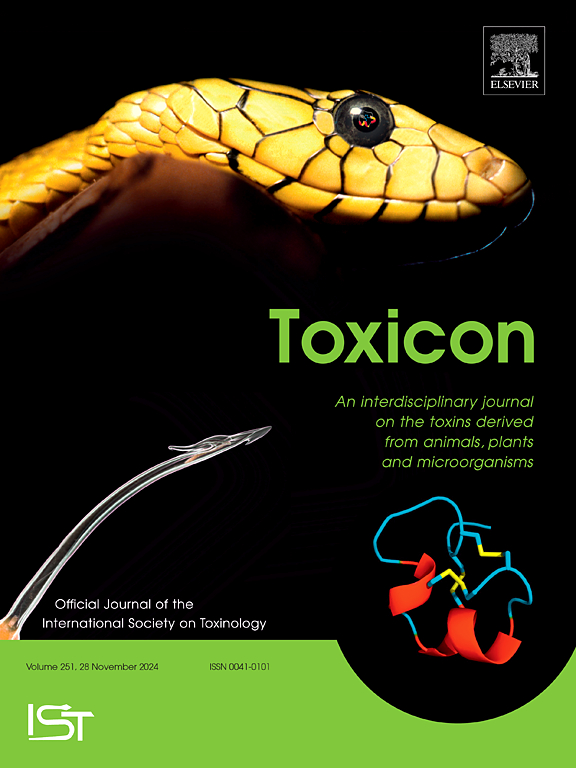State of the art on the development of a recombinant antivenom against Mexican scorpion stings
IF 2.6
4区 医学
Q2 PHARMACOLOGY & PHARMACY
引用次数: 0
Abstract
Around 2,750 species of scorpions have been recorded worldwide and classified into 21 families and 208 genera. Of these, the family Buthidae stands out as one of the largest, comprising several genera including the genus Centruroides with 102 recorded species. This genus is home to the largest number of species dangerous to humans as described in Mexico, where there are 55 species of the genus Centruroides, of which more than 24 are of medical importance. Envenoming in humans is caused by the presence of peptides (toxins) in the venom that modify the gating mechanism of Na+ voltage dependent ionic channels. Therefore, a rational approach to generate a new antivenom is to obtain neutralizing antibodies against these toxins, whose average abundance in venom is 10%. In this review paper, we document that from the characterization of the lethal venoms of Mexican scorpions, 30 lethal components have been identified, so their neutralization represents an enormous challenge. Thanks to phage display and directed evolution technologies, it has been possible to generate specific antibody fragments against several of these toxins, some of which exhibit broad cross-neutralization. Currently, progress has been made in neutralizing the venoms of 9 species with the use of recombinant antibody fragments, mainly of human origin. One of them has the potential to neutralize approximately 20 toxins.

针对墨西哥蝎子螫伤的重组抗蛇毒血清的最新进展
全世界有记录的蝎子约有2750种,分为21科208属。其中,Buthidae家族是最大的一个,包括几个属,包括有102种记录的Centruroides属。该属是墨西哥所描述的对人类有危险的物种数量最多的物种,那里有55种Centruroides属,其中超过24种具有医学重要性。人类的中毒是由毒液中肽(毒素)的存在引起的,这些肽(毒素)改变了Na+电压依赖性离子通道的门控机制。因此,制备新型抗蛇毒血清的合理方法是获得针对这些毒素的中和抗体,这些毒素在毒液中的平均丰度为10%。在这篇综述论文中,我们记录了墨西哥蝎子致命毒液的特征,已经确定了30种致命成分,因此它们的中和代表了一个巨大的挑战。由于噬菌体展示和定向进化技术,已经有可能产生针对几种这些毒素的特异性抗体片段,其中一些表现出广泛的交叉中和。目前,利用重组抗体片段(主要来自人类)中和9种蛇毒的研究取得了进展。其中一种能中和大约20种毒素。
本文章由计算机程序翻译,如有差异,请以英文原文为准。
求助全文
约1分钟内获得全文
求助全文
来源期刊

Toxicon
医学-毒理学
CiteScore
4.80
自引率
10.70%
发文量
358
审稿时长
68 days
期刊介绍:
Toxicon has an open access mirror Toxicon: X, sharing the same aims and scope, editorial team, submission system and rigorous peer review. An introductory offer Toxicon: X - full waiver of the Open Access fee.
Toxicon''s "aims and scope" are to publish:
-articles containing the results of original research on problems related to toxins derived from animals, plants and microorganisms
-papers on novel findings related to the chemical, pharmacological, toxicological, and immunological properties of natural toxins
-molecular biological studies of toxins and other genes from poisonous and venomous organisms that advance understanding of the role or function of toxins
-clinical observations on poisoning and envenoming where a new therapeutic principle has been proposed or a decidedly superior clinical result has been obtained.
-material on the use of toxins as tools in studying biological processes and material on subjects related to venom and antivenom problems.
-articles on the translational application of toxins, for example as drugs and insecticides
-epidemiological studies on envenoming or poisoning, so long as they highlight a previously unrecognised medical problem or provide insight into the prevention or medical treatment of envenoming or poisoning. Retrospective surveys of hospital records, especially those lacking species identification, will not be considered for publication. Properly designed prospective community-based surveys are strongly encouraged.
-articles describing well-known activities of venoms, such as antibacterial, anticancer, and analgesic activities of arachnid venoms, without any attempt to define the mechanism of action or purify the active component, will not be considered for publication in Toxicon.
-review articles on problems related to toxinology.
To encourage the exchange of ideas, sections of the journal may be devoted to Short Communications, Letters to the Editor and activities of the affiliated societies.
 求助内容:
求助内容: 应助结果提醒方式:
应助结果提醒方式:


